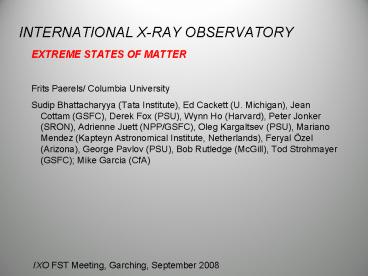INTERNATIONAL XRAY OBSERVATORY - PowerPoint PPT Presentation
1 / 13
Title:
INTERNATIONAL XRAY OBSERVATORY
Description:
Sudip Bhattacharyya (Tata Institute), Ed Cackett (U. Michigan), Jean Cottam ... Sudip Bhattacharya (Tata/FST) Spin frequencies: 0, 300, 500 Hz (75 deg inclination, ... – PowerPoint PPT presentation
Number of Views:29
Avg rating:3.0/5.0
Title: INTERNATIONAL XRAY OBSERVATORY
1
INTERNATIONAL X-RAY OBSERVATORY
- EXTREME STATES OF MATTER
- Frits Paerels/ Columbia University
- Sudip Bhattacharyya (Tata Institute), Ed Cackett
(U. Michigan), Jean Cottam (GSFC), Derek Fox
(PSU), Wynn Ho (Harvard), Peter Jonker (SRON),
Adrienne Juett (NPP/GSFC), Oleg Kargaltsev (PSU),
Mariano Mendez (Kapteyn Astronomical Institute,
Netherlands), Feryal Özel (Arizona), George
Pavlov (PSU), Bob Rutledge (McGill), Tod
Strohmayer (GSFC) Mike Garcia (CfA)
IXO FST Meeting, Garching, September 2008
2
Extreme States of Matter Key Question
- What is the equation of state of matter at
supranuclear densities?
Interiors of neutron stars present extremes of
density not found anywhere else in the
Universe Nature of matter in these conditions a
deep mystery entirely new states may be
present Neutron star massradius measurements
will test current models of QCD Unique
opportunity with IXO unveil fundamental
properties of matter at highest densities
?
15 to 35 (?) km
Unknown composition
Where ? could be hyperon condensate, pion
condensate, kaon condensate, strange quark
matter, quark-gluon plasma
3
Neutron Star Observations
- Probe high-density, low-temperature regime
inaccessible to particle experiments - Joint massradius constraints are needed to test
QCD pulsar timing does not do it (c.f. double
pulsars moment of inertia) - IXO enables multiple independent approaches
- X-ray burst spectroscopy (simulation)
- X-ray burst pulse profiles
- Continuum spectra of NS _at_ known distance
4
Burst Spectroscopy
Curve of growth for Fe XXVI Ha analog in EXO0748
Cottam, Paerels, Mendez 2002
Pressure broadening (Stark effect) ! Measure z
and g M and R
5
Simulated spectrum EXO0748-676, 100 ksec with
microcalorimeter Sensitivity requirement 20
eV EW in n2-3 Can easily see important higher
order series members
6
Burst Spectroscopy with IXO
- Scale expected number of burst photons to
EO0748-676 - At least a dozen good targets
- Source FoM Peak (C) Wait (h)
- 1745-248 8.00 1.21 0.54
- 1826-24 3.55 1.04 3.98
- 1608-52 3.12 3.98 5.82
- 1748.9-2021 2.90 1.60 1.39
- 1731-26 2.90 1.60 2.89
- GX_172 2.65 11.45 9.82
- 1705-44 2.34 1.44 1.31
- 1728-34 2.00 2.79 3.52
- 1636-536 1.90 2.56 2.50
- 0836-429 1.77 0.69 2.20
- 1735-44 1.21 1.30 1.18
- 1808-369 1.11 1.84 25.46
- 0748-676 1.00 1.60 2.54
7
Burst Spectroscopy with IXO NS Spin
- Absorption line profile broadens with increasing
NS spin frequency - Both a bonus (profile shape gives R) and a
drawback (reduced contrast) - Detection and profile measurement remain feasible
up to 500 Hz!!
Spin frequencies 0, 300, 500 Hz (75 deg
inclination, 10 deg equatorial belt, 1.4 MO, R
11 km)
from Ed Cackett (Umich/ FST), Sudip Bhattacharya
(Tata/FST)
8
Neutron Stars at Known Distance qLMXB
Characteristic distortions of continuum (not BB)
allow simultaneous redshift and Teff know d,
get R and M
For now qLMXB in GC
Courtesy Bob Rutledge (McGill/FST)
INS Isolated Neutron Star qLMXB quiescent Low
Mass X-ray Binary GC Globular Cluster
9
Pulse Shape of Burst Oscillations
- known spin period and Doppler shift R
- GR light bending z find M and R
Tod Strohmayer (GSFC/FST)
Need to carefully evaluate high count rate
effects/limitations
10
Accreting NS versus Radiopulsars (binary
pulsar)X-ray spectroscopy samples different
masses
Lattimer Prakash 2007
11
Constellation-X ?IXO capabilities
- larger effective area at 1 keV GOOD (more
objects and/or more time - resolution in bursts)
- increased angular resolution PROBABLY NOT GOOD
- increased Field of View NOT RELEVANT
- sensitivity gt 10 keV NOT RELEVANT
- trade off between count rate and energy
resolution in XMS - effect on burst spectroscopy and timing
To be determined
12
(a few night thoughts testing QCD we will
test the many-body behavior of QCD- not the
foundations of the theory Need to evaluate
claims that LHC or RHIC could do
high- density/zero temperature regime Range
in M-R due to uncertainties in EOS may be
SMALLER than range due to untested variations on
GR if we find a NS with M 1.5 MO, R gt 15 km,
we are testing the correct relativistic EHE(),
not the EOS! (point due to Dimitris
Psaltis) ) () Equation of Hydrostatic
Equilibrium
13
(No Transcript)































